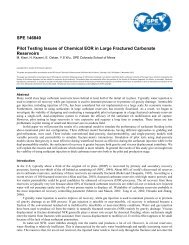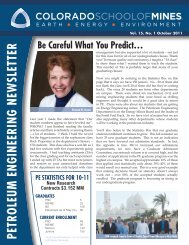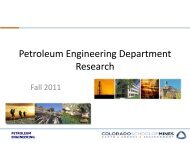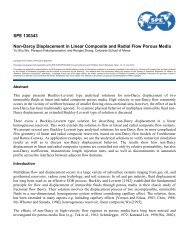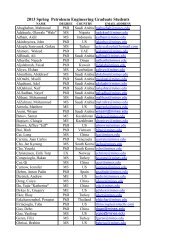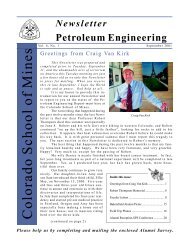A Coupled Flow-Geomechanics Model for Fluid and ... - OnePetro
A Coupled Flow-Geomechanics Model for Fluid and ... - OnePetro
A Coupled Flow-Geomechanics Model for Fluid and ... - OnePetro
- No tags were found...
You also want an ePaper? Increase the reach of your titles
YUMPU automatically turns print PDFs into web optimized ePapers that Google loves.
ARMA 11-213A <strong>Coupled</strong> <strong>Flow</strong>-<strong>Geomechanics</strong> <strong>Model</strong> <strong>for</strong> <strong>Fluid</strong> <strong>and</strong> Heat <strong>Flow</strong> <strong>for</strong>Enhanced Geothermal ReservoirsPerapon Fakcharoenphol <strong>and</strong> Yu-Shu WuColorado School of Mines, Golden, CO, US.Copyright 2011 ARMA, American Rock Mechanics AssociationThis paper was prepared <strong>for</strong> presentation at the 45 th US Rock Mechanics / <strong>Geomechanics</strong> Symposium held in San Francisco, CA, June 26–29,2011.This paper was selected <strong>for</strong> presentation at the symposium by an ARMA Technical Program Committee based on a technical <strong>and</strong> critical review ofthe paper by a minimum of two technical reviewers. The material, as presented, does not necessarily reflect any position of ARMA, its officers, ormembers. Electronic reproduction, distribution, or storage of any part of this paper <strong>for</strong> commercial purposes without the written consent of ARMAis prohibited. Permission to reproduce in print is restricted to an abstract of not more than 300 words; illustrations may not be copied. Theabstract must contain conspicuous acknowledgement of where <strong>and</strong> by whom the paper was presented.ABSTRACT: This paper presents a numerical model <strong>for</strong> simulating coupled fluid flow, heat transfer, <strong>and</strong> geomechanics inenhanced geothermal systems (EGS). The developed simulator is built on the TOUGH2 [1], a well-established simulator <strong>for</strong> geohydrologicalanalysis with multiphase, multi-component fluid <strong>and</strong> heat flow [2]. The key capability <strong>for</strong> an EGS simulator is how toh<strong>and</strong>le fluid <strong>and</strong> heat flow in such multi-scale fractured systems. In the model, we represent different-scaled fractures or fracturedzones using hybrid fracture model. In h<strong>and</strong>ling the effect of rock de<strong>for</strong>mation, we use the simplified model of the uniaxial strain.The numerical scheme is verified against the analytical solutions of the classical one-dimensional consolidation problem <strong>and</strong> onedimensionalheat conduction in de<strong>for</strong>mable rock column. To demonstrate the capability of our model, a closed loop circulation ofan EGS reservoir with one injector <strong>and</strong> one producer is simulated. The results show that thermal-induced stresses are morepronounced than pressure-induced stresses, especially, close to the injector well. While the vertical stress is relatively constantthroughout the simulation run, the horizontal stresses reduce significantly. As a result, the stress changes may exceed rockstrength, creating new fractures or reactivating healed natural fractures.1. INTRODUCTIONMost geothermal reservoirs are situated in igneous <strong>and</strong>metamorphic rocks that have low matrix permeability.Well-connected fractures provide high permeable fluidflowpath to un-fractured tight rock matrix. Under anexternal stimulus, the contrast of rates ofthermodynamics changes between high permeablefractures <strong>and</strong> tight matrix rock causes largethermodynamics variation between the two media. Inenhanced geothermal reservoirs, natural cracks <strong>and</strong>fractures are typically scarce. Artificial fractures orhydraulic fractures are required to provide highpermeable paths <strong>for</strong> fluid <strong>and</strong> heat flow to wells.Mechanical de<strong>for</strong>mation process in porous <strong>and</strong> fracturedrock <strong>and</strong> their coupling to thermal <strong>and</strong> hydrologicalprocesses are important in enhanced geothermal systems(EGS) [3]. Stresses <strong>and</strong> strains changes due to externaldisturbances, e.g. cold-water injection, causesde<strong>for</strong>mation in rock frame. This de<strong>for</strong>mation, in turn,alters hydraulic properties, such as porosity <strong>and</strong>permeability, <strong>and</strong> affects fluid <strong>and</strong> heat flow. Thus, tosimulate this complex system, it is important to: 1)include the effect of stresses/strain changes on hydraulicproperties, especially fractured rock, <strong>and</strong> 2) account <strong>for</strong>multi-scaled fractures.2. MATHEMATICAL MODEL2.1. TOUGH2 mathematical frameworkThe general framework mathematical <strong>and</strong> numericalmodel solves mass <strong>and</strong> energy balance equations ofdescribing fluid <strong>and</strong> heat flow in general multiphase,multi-component systems. <strong>Fluid</strong> flow is described with amultiphase extension of Darcy’s law; in addition, thereis diffusive mass transport in all phases. Heat flow isgoverned by conduction <strong>and</strong> convection, also includingsensible as well as latent heat effects. Following [1], themass <strong>and</strong> heat balance equations in every model subdomainor REV of an EGS can be written in the <strong>for</strong>m:d κκκ∫ M dVn= ∫ F • ndΓn+ ∫ q dVn(1)dtVnΓnκ= 1, ..., NK (total number of components) <strong>and</strong> n=1,…,NEL (total number of gridblocks).The integration in Eq. (1) is over an arbitrary subdomainor a control volume, V n , of the flow system under study,which is bounded by the closed surface Γ n . The quantityM appearing in the accumulation term (left h<strong>and</strong> side)Vn
epresents mass or energy per unit volume, F denotesmass or heat flux (see below), <strong>and</strong> q denotes sinks <strong>and</strong>sources. n is a normal vector on surface element dΓ n ,pointing inward into V n .F nmA nmwhere, x i,p represents the value of i th primary variable atthe p th iteration step.In evaluation of the terms in Eq. (2), mass accumulation,flux, source <strong>and</strong> sink must be calculated at each Newtoniteration step. The general <strong>for</strong>m of the massaccumulation term is:∑κκM = φSβρβXβ(4)κ = 1, ..., NK, <strong>and</strong> β=1, …NPH (total number of phases).Fig. 1. Space discretization <strong>and</strong> flow-term determination in theintegral finite difference method [1].For numerical simulation the continuous space <strong>and</strong> timevariables must be discretized using the integral finitedifference method (IFDM, [4]), as shown in Fig. (1)IFDM avoids any reference to a global system ofcoordinates, <strong>and</strong> thus offers the advantage of beingapplicable to regular or irregular discretization in one,two, <strong>and</strong> three dimensions of porous <strong>and</strong> fracturedmedia. The IFDM also makes it possible, by means ofsimple preprocessing of geometric data, to implementdouble- <strong>and</strong> multiple-porosity methods <strong>for</strong> modelingflow in fractured media. Time will be discretized fullyimplicitly as a first-order backward finite difference.Time <strong>and</strong> space discretization of Eq. (1) results in a setof coupled non-linear equations, which can be written inresidual <strong>for</strong>m as follows [1]:Rκn( xt + 1∆t− {Vn) = M∑mAnmκnF( xκnmt + 1( x) − Mt + 1κnn( x) + V qt)κ , t + 1nwhere, the vector x t consists of primary variables at timeκt, Rnis the residual of component κ <strong>for</strong> grid block n, Mdenotes mass or thermal energy per unit volume <strong>for</strong> acomponent, V n is the volume of the block n, q denotessinks <strong>and</strong> sources of mass or energy, ∆tdenotes thecurrent time step size, t+1 denotes the time level oft+ ∆ t , A nm is the interface area between neighboringblocks n <strong>and</strong> m, <strong>and</strong> F nm is the “flow” term (includingfluid flow, heat transfer, <strong>and</strong> advective <strong>and</strong> diffusivemass transport) between them. Eq. (2) is solved byNewton/Raphson iteration, leading to}(2)κ,t+1∂Rn κ,t+1− ∑ (xi,p+1− xi,p) = Rn(xi,p) (3)∂xiipwhere, φ is porosity,ρ βis density of phase β,Sβis theκsaturation of phase β, <strong>and</strong> Xβis the mass fraction ofcomponent κ in phase β. Be<strong>for</strong>e the calculation of massaccumulation, the parameters on the right h<strong>and</strong> side ofEq. (4) are calculated as a function of primary variables,which are directly solved from Eq. (3) <strong>for</strong> previousNewton iteration step, or from initial conditions at firstiteration.The heat accumulation term includes contributions fromthe rock matrix, gaseous <strong>and</strong> fluid phases <strong>and</strong> is given byequation:Mκ∑= ( 1−φ)ρ C T + φ S ρ u (5)κ = NK+1 (NK+heat component) <strong>and</strong> β=1,…, NPH.RHere ρR<strong>and</strong>C Rare grain density <strong>and</strong> specific heat of thehost rock respectively, T is temperature, <strong>and</strong> u βisspecific internal energy in phase β.The mass fluxes of aqueous <strong>and</strong> gaseous phases aredetermined by a multiphase version of Darcy’s law,written in the <strong>for</strong>m:Fβb krβρ β= −k0 (1 + ) ( ∇Pβ− ρ β g)P µββ=1, ..., NMPH (total number of mobile phases).βRββββ(6)where, k 0 is absolute permeability, b is the Klinkenbergfactor [5] <strong>for</strong> gas slippage effect (b=0 when β=aqueousphase), krβis relative permeability to phase β, µ βisviscosity, Pβis pressure in the β phase, <strong>and</strong> g is thevector of gravitational acceleration.The diffusive fluxes are evaluated by the <strong>for</strong>mulationprovided:κκ κJ = −φτρ d ∇X(7)βββββ
κwhere, dβis the molecular diffusion coefficient <strong>for</strong>component κ in phase β, τ βis the tortuosity which is afunction of rock property <strong>and</strong> phase saturation, <strong>and</strong>X is mass fraction of component κ in phase β.κβstresses <strong>and</strong> strains. No additional primary variable isrequired. Thus, the computational workload required <strong>for</strong>coupled geomechanics to a flow simulator is minimal.A reservoirThe heat flux term accounts <strong>for</strong> conduction, advection<strong>and</strong> radiation heat transfer, <strong>and</strong> is given by:Fκ= −[(1−φ)K+ fσσ ∇T0R4+ φ+∑∑ββ = 1,2,3hββ = 1,2SFβKβ] ∇T(8)(a)where, KRis thermal conductivity of the rock, K βisthermal conductivity of phase β, T is temperature, hβisspecific enthalpy of phase β, fσis radiant emittancefactor, <strong>and</strong> σ0is the Stefan-BoltzmannA reservoir2.2. coupled geomechanicsA fully coupled flow-geomechanics model inheritsexpensive computation workload caused by additionalthree primary variables. For example, in a two-phaseblack-oil system, two primary variables (pressure <strong>and</strong>,saturation) are required. Coupling geomechanics-flowinvolves five primary variables <strong>and</strong> simultaneous solvingthis model can cause more than quadruple incomputational time of the flow model. Many researchers[2, 6, 7], thus, focus on sequential-coupling technique toreduce computational time. However, the sequentialtechnique does not guarantee mass or energyconservation. Iteration between flow <strong>and</strong> geomechanicsis required to minimize the mass balance error.We <strong>for</strong>mulated a boundary-based simplified coupledflow-geomechanics model which simultaneously solvingfluid, heat flow <strong>and</strong> geomechanics equations. Thus, mass<strong>and</strong> energy conservations are guaranteed. A typicalcoupled flow-geomechanics model assumes the unde<strong>for</strong>mableboundary at the lateral <strong>and</strong> bottom modelboundaries, <strong>and</strong> the constant stress boundary at the topof the model, see Fig. 2a. Rock de<strong>for</strong>mations between anelement <strong>and</strong> its neighboring elements follow <strong>for</strong>cesbalance equations <strong>and</strong> a stress-strain relationship. In our<strong>for</strong>mulation, we eliminate <strong>for</strong>ce interaction of eachelement <strong>and</strong> impose boundary conditions, used <strong>for</strong>model outer boundaries, on each element interface. Forexample, we can impose the uniaxial strain boundary,un-de<strong>for</strong>mable boundary at the lateral <strong>and</strong> bottominterfaces <strong>and</strong> constant stress boundary at the top, toevery element, see Fig. 2b. Using this <strong>for</strong>mulation, wecan directly calculate pressure <strong>and</strong> temperature induced(b)Fig. 2. Mechanical boundary condition of (a) a typical coupledflow-geomechanics model <strong>and</strong> (b) the proposed coupled flowgeomechanicsmodel.Under the thermo-poro-elastic <strong>and</strong> the small strainassumptions, pressure <strong>and</strong> temperature induced stresses<strong>and</strong> strains can be expressed as follows:(i)Uniaxial strain: un-de<strong>for</strong>mable boundary at thelateral <strong>and</strong> bottom interfaces, <strong>and</strong> constant stressboundary at the top interface of an element⎛1−2ν⎞ ⎛ E ⎞∆σh= ⎜ ⎟αP∆P+ ⎜ ⎟αT∆T⎝ 1−ν⎠ ⎝1−ν⎠(9)ν ⎛ E ⎞∆σ' h= − αP∆P+ ⎜ ⎟αT∆T1−ν⎝1−ν⎠(10)σ = 0(11)∆ v∆σ ' = −α∆P(12)vP( 1 + ν )( 1 − 2ν)E( 1 −ν)1 + νεv= − αT∆T− αP∆P(13)1 −ν
(ii)(iii)where,∆ σh, ∆σvare total stress changes inhorizontal <strong>and</strong> vertical directions, respectively,∆ σ ' h, ∆ σ ' vare effective stress changes inhorizontal <strong>and</strong> vertical directions, ∆ P is pressurechange, ∆ T is temperature change, ν is Poissonratio, E is Young modulus, αPis Biot constant,αTis linear thermal expansion, <strong>and</strong> εvis volumemetric strain, where positive sign indicatesexpansion <strong>and</strong> negative sign indicates contraction.Un-de<strong>for</strong>mable boundary: un-de<strong>for</strong>mableboundary at all interfaces of an elementE∆σh= ∆σv= αP∆P+ αT∆T1−2ν(14)E∆σ'h= ∆σ'v= αT∆T(15)1−2νεv= 0(16)Constant stress boundary: constant stress boundaryat all interfaces of an element∆σ = ∆σ= 0(17)hv∆σ' = ∆σ' = −α∆P(18)hvP( 1− 2ν)εv= −αT∆T−αP∆P(19)E2.3. Stress dependent hydraulic propertiesIt has been recognized <strong>for</strong> over half a decade thatpermeability of s<strong>and</strong> stone cores is reduced by anapplied, external stress [9]. Under a reservoir condition,fluid production <strong>and</strong> injection causes stress changes <strong>and</strong>de<strong>for</strong>mation in a reservoir. Rock porosity <strong>and</strong>permeability are altered as the consequence. Manyresearch ef<strong>for</strong>ts have been made to quantify thesechanges. Number of stress/strain induced porosity <strong>and</strong>permeability change correlations are available inliterature [10 – 14]. The selected numerical schememake possible to incorporate these correlations as userselectable options. The general <strong>for</strong>m of porosity <strong>and</strong>permeability change is as follows:φ = φ( σ ', ε )(20)k = k( σ ', ε )(21)where, φ is porosity, k is permeability, σ ' is effectivestress, <strong>and</strong> ε is strain.Capillary pressure can be scaled according to theLeverett J-function [2].pc=pc0⎛⎜⎜⎝k ⎞0/ φ0⎟k / φ ⎟⎠(22)where, k0is reference permeability, φ0is referenceporosity, pcis capillary pressure, <strong>and</strong> pc0is capillarypressure at reference porosity <strong>and</strong> permeability.Emphasis should be made <strong>for</strong> the hydraulic properties ofthe fractured medium. Rutqvist et al. [2] developed anempirical correlation <strong>for</strong> fracture hydraulic propertieschanges caused by stress alteration. They correlatedfracture width using an exponentially decaying pathbetween zero-effective-stress fracture width <strong>and</strong>residual-high-stress fracture width. Porosity <strong>and</strong>permeability, then, can be calculated from the computedfracture width.' '[ d( σ −σ)]w = wi+ ( w0 −wr) expn ni(23)where, w is fracture width,wi, w0,zero-stress, <strong>and</strong> residue fracture width,w are the initial,rσ , σ arenormal effective stress <strong>and</strong> the initial normal stress, <strong>and</strong>d is experimental fitting curve.w1+ w2+ w3φ = φi(24)w + w + w1iwhere, φiis the initial porosity, w is fracture width ofthe fracture set 1, 2, <strong>and</strong> 3 where they are parallel to x, y,<strong>and</strong> z direction, subscript i indicates the initial condition.k13232i2i3333i3i'n'niw + w= k1i(24)w + wwhere, k 1 iis the initial permeability of direction 1, w 2 ,w 3 are fracture width of the fracture set normal todirection 1.2.4. Hybrid fracture modelingA typical EGS reservoir required massive hydraulicstimulation to achieve economic production [9]. Thefracture created by the stimulation can be considerablylarge. As such, it raises the challenge on how to modelthe system where there co-exist multi-scale fractures, alarge hydraulic fracture <strong>and</strong> small pre-existing naturalfractures. Two modeling approaches, explicitdiscretization <strong>and</strong> conceptualization, such as dualporosity,dual-permeability, <strong>and</strong> multi-interactioncontinuum (MINC) are discussed in literatures [15 – 19].The <strong>for</strong>mer approach deals with actual fracture geometry
<strong>and</strong> models them accordingly. It is well suited <strong>for</strong>modeling a hydraulic fracture where the fracturegeometry is known. The conceptual approach, on theother h<strong>and</strong>, captures heat <strong>and</strong> fluid flows betweenfracture <strong>and</strong> matrix media using idealized fracturematrixnetworks. It is appropriate <strong>for</strong> modeling naturalfractures where the geologic detail is complex <strong>and</strong>available data is rather incomplete [16].The integral finite difference method discussed in theprevious section, makes possible to implement allfractured modeling approaches a<strong>for</strong>ementioned in thesame framework. Each fractured modeling can be treatedas a geometric preprocessing input while allcomputational procedures are all the same. The “flow”term ( F ) in Eq. (6) <strong>for</strong> multiphase flow is described byβa discrete version of Darcy’s law. This is the mass fluxof fluid phase β along the connection of element i <strong>and</strong> j,given byFβ, i j= λβ, ij+ 1/ 2γi j( ψβ j−ψβ i) (25)where λ β,i j+1/2 is the mobility term to phase β, defined as⎛⎛ ⎞, + 1/ 21⎟ ⎟ ⎞⎜⎜b ρβkrβλ + ⎟β i j(26)⎜⎝⎝Pβ⎠ µβ ⎠=ij+1/ 2<strong>and</strong> subscript ij+1/2 denotes a proper averaging orweighting of properties at the interface between twoelements i <strong>and</strong> j, γijis transmissivity calculated as:whereγi jijAijk=d + dii j+1/ 2j(27)A is the common interface area betweenconnected blocks or nodes i <strong>and</strong> j; d i is the distance fromthe center of block i to the interface between blocks i <strong>and</strong>j; <strong>and</strong> k ij+1/2 is an averaged (such as harmonic weighted)absolute permeability along the connection betweenelements i <strong>and</strong> j.The flow potential term in Equation (25) is defined asψ = − ρ g D(28)β iPβ i β,ij+1/ 2where D i is the depth to the center of block i from areference datum.To implement all fractured modeling approaches, specialattention is needed to calculate fracture-matrix masstransfer where a quasi-steady state is assumed, e.g. inDouble-porosity <strong>and</strong> Dual-permeability. The flowbetween fractures <strong>and</strong> matrix is still evaluated using Eq.(25); however, the transmissibility <strong>for</strong> the fracturematrixflow is given byiAFMkγij=lFMM(29)where A FM is the total interface area between fractures<strong>and</strong> matrix of element i <strong>and</strong> j (one of them is a fracture<strong>and</strong> the other is a matrix blocks); k M is a matrix absolutepermeability; <strong>and</strong> l FM is a characteristic distancerepresenting an equivalent length of average matrixblock pressure <strong>for</strong> a quasi-steady state flow. It can becalculated <strong>for</strong> idealized 1-D, 2-D <strong>and</strong> 3-D dimensionalrectangular matrix blocks when using the doubleporositymodel [4, 17].Fig. 3 shows the example model <strong>for</strong> an EGS reservoir.The hydraulic fracture is modeled by discrete fractureapproach <strong>and</strong> preexisting natural fractures are capturedby the multi-continuum conceptualization.WellDiscrete fractureMINC , Dual-porosity,or dual-permeabilitySingle porosityFig. 3. An EGS model where a hydraulic fracture is modeledby discrete fracture approach <strong>and</strong> preexisting natural fracturesare captured by the multi-continuum modeling approach.3. MODEL VERIFICATIONSTo verify our numerical model two classical problemswere simulated <strong>and</strong> the results were compared toanalytical solution.3.1. One-dimensional heat conduction in thede<strong>for</strong>mable columnThe problem is heat conduction a solid rock column thatundergoes uniaxial strain in the vertical direction only.The column is subjected to a low temperature boundaryon the top, see Fig. 6. Only heat conduction is assumed.The cooling effect caused contraction. As heatconduction is a slow process, the semi-infinite space
solution is used to compare with the numerical results.Table 1 shows detail input parameters.Fig. 6a <strong>and</strong> 6b show the comparison between numericalresults <strong>and</strong> analytical solution. The excellent match isachieved which lend creditability to our mathematical<strong>for</strong>mulation.Constant temperature (T b ) at 10 °CT i =60 °CTable 1. Input parameters <strong>for</strong> one-dimensional consolidationproblemParameter Value Unit<strong>Model</strong> 1 ×1×100Grid size ∆x = 1, ∆y = 1, m.∆z = 0.5Heat conductivity (k T ) 2.34 W/m°KHeat capacity of rock (c s ) 690 J/kg°KRock density (ρ s ) 2,550 Kg/m 3Linear thermal expansion (α T ) 1.5×10 -6 K -1Young modulus (E) 14.4×10 9 PaPoisson ratio(ν) 0.20Fig. 6. Configuration of one-dimensional heat conduction inde<strong>for</strong>mable media problem0.01.6E-03Depth, m10.020.030.040.0t=1.0e6 sec.t=1.0e7 sec.t=1.0e8 sec.Analytical solutionNumerical ResultsVertical Displacement, m1.4E-031.2E-031.0E-038.0E-046.0E-044.0E-042.0E-04Analytical SolutionNumerical Results50.00.0 20.0 40.0 60.0Temperature, °C(a)0.0E+001.0E+04 1.0E+05 1.0E+06 1.0E+07 1.0E+08 1.0E+09Time, sec(b)Fig. 6. The comparisons between numerical <strong>and</strong> analytical solutions (a) temperature profile <strong>and</strong> (b) the displacement at the top ofthe column.3.2. One-dimensional consolidationThe problem concerns a porous permeable column thatundergoes uniaxial strain in the vertical direction only.The column is subjected to a constant load on the top,the fluid boundary pressure is set to zero gauge rightafter the load is imposed, <strong>and</strong> only vertical displacementtakes place, see Fig. 4. The numerical simulation wasinitialized at the undrained condition, as all subsurfacereservoirs is in the condition when they are discovered<strong>and</strong> our numerical model cannot capture <strong>for</strong>ceinteraction <strong>and</strong> de<strong>for</strong>mation of each element interface ofthe undrained process. Thus, only drained process withstresses <strong>and</strong> strains changes is simulated. Detail inputparameters can be found in Table 2. The results arecompared with Jaeger's analytical solution [20]. Theanalytical solution can also be found in [21]. Thepressure profiles <strong>and</strong> the de<strong>for</strong>mation at the of rockcolumn are shown in Fig 5a <strong>and</strong> 5b, respectively. Themodel can capture pressure change in various times <strong>and</strong>the top model de<strong>for</strong>mation profile with time.
σ ex =14.2 MPaFig. 4. Configuration of one-dimensional consolidationproblem.Table 2. Input parameters <strong>for</strong> one-dimensional consolidationproblemParameter Value Unit<strong>Model</strong> 1 ×1×100Grid size ∆x = 1, ∆y = 1, m.∆z = 0.5Porosity (φ) 0.19Permeability (k) 10 -13 m 2Rock compressibility (c φ ) 4.4×10 -10 Pa -1<strong>Fluid</strong> Density (ρ) 1000 Kg/m 3<strong>Fluid</strong> Viscosity (µ) 0.89×10 -3 Pa.s<strong>Fluid</strong> compressibility (c f ) 6.0×10 -10 Pa -1Biot coefficient (α P ) 0.8Young modulus (E) 14.4×10 9 PaPoisson ratio(ν) 0.20Initial pressure (P i ) 3×10 6 Pa0.00.006Normalized Depth0.20.40.6t=3000 sect=1000 sect=100 secVertical Displacement, m0.0050.0040.0030.0020.8AnalyticalsolutionNumerical Results0.001Analytical SolutionNumerical Results1.00.0 0.2 0.4 0.6 0.8 1.0Normalized Excess Pressure(a)0.0001.0E-05 1.0E-03 1.0E-01 1.0E+01 1.0E+03 1.0E+05Time, sec(b)Fig. 5.The comparisons between numerical <strong>and</strong> analytical solutions (a) pressure profile <strong>and</strong> (b) the displacement at the top of thecolumn.4. EXAMPLE APPLICATIONAn example geothermal reservoir model was run toshow capability of our model. A pair of injection<strong>and</strong> production wells is placed in a deep EGSbasement reservoir. Three large fractures/faults inhorizontal plain are encountered from both wells.Hydraulic stimulation was per<strong>for</strong>med. The seismicdata indicate micro-seismic activity in large volume[22].A three-dimensional model is created to simulateeffect of cool water injection. The model consists ofthree types of rock, 1) tight matrix block wheresingle-porosity is used, 2) large fracture zonemodeled by discrete fracture model, <strong>and</strong> 3) crushedzone where small fractures exist, but the no fracturegeometry data is available, thus dual-porosity modelis used, see Fig.7.After 10 years of circulation, temperature aroundthe injector is reduced significantly where aspressure change is minimal see Fig. 8. This coolingeffect cause contraction of rock <strong>and</strong> the effectivehorizontal stress is decreased substantially. On theother h<strong>and</strong>, the vertical stress is relatively constantthroughout the run. The Mohr-circle plot shows inFig. 9.indicated that the stress state is approachingrock failure line as time goes by. Eventually thestress changes may exceed rock strength, creatingnew fractures or reactivating healed naturalfractures.
InjectorProducerTight matrixCrushed zoneLarge fractureCrushed zone0.6 kmθ=7°3.0 kmFig. 7. Configuration of reservoir model in Cooper basin where one cold water injector <strong>and</strong> one producer in the reservoir.T (°C) : T i =250 °Ca)60 100 140 180 220P (Pa) : P i =7.40 E+7b)7.51E+077.535E+07σ‘ H (Pa) : σ‘ H,i =4.88 E+8c)2.8E+08 3.8E+08 4.8E+08σ‘ v (Pa) : σ‘ v,i =6.65 E+8d)6.6452E+086.6466E+08ε v (dimensionless)e)0.001 0.004 0.007 0.01Fig. 9. Simulation results after 10 years of 20 kg/s injection <strong>and</strong> production using Uniaxial-strain assumption: a) temperature, b)pressure, c) effective horizontal stress, d) effective vertical stress, <strong>and</strong> d) volume metric strain.
Shear stressσ' 3,t2 σ' 3,t1 σ' 3,t0Effective normal stressσ' 1Fig. 10. General stress change in Mohr-Coulomb plot5. CONCLUSSIONS• We developed a coupled flow-geomechanicsmodel based on simplified assumptions wherestresses <strong>and</strong> strains can be directly calculatedfrom pressure <strong>and</strong> temperature changes, noadditional primary variable is required innumerical solutions. Thus, minimal additionalcomputational workload is needed to solvecoupled flow-geomechanics comparing to that offlow simulator.• The numerical scheme is successfully verifiedagainst analytical solutions of one-dimensionalconsolidation <strong>and</strong> one-dimensional heatconduction in de<strong>for</strong>mable media.• Hybrid fracture model is used to capture multiscalefractures in an EGS reservoir. Hydraulicfractures can be modeled using discretemodeling approach whereas multi-continuumfracture model can apply to pre-existing naturalfractures.• In an EGS reservoir, temperature induced stressis much more pronounce than that of pressureinduced stresses, especially at vicinity to a coldwaterinjection well. The stress change cancause rock failure <strong>and</strong> consequently, create orreactivate new fractures.ACKNOWLEDGMENTThis work is supported by the U.S. Department ofEnergy under Contract No. DE-EE0002762,“Development of Advanced Thermal-Hydrological-Mechanical-Chemical (THMC) <strong>Model</strong>ing Capabilities<strong>for</strong> Enhanced Geothermal Systems“REFERENCES1. Pruess, K, C. Oldenburg, <strong>and</strong> G. Moridis, 1999,TOUGH2 user’s guide, V2.0. Lawrence BerkeleyNational Laboratory Report LBNL-43134, Berkeley,CA.2. Rutqvist, J., Y. S. Wu, C. F. Tsang, <strong>and</strong> G. Bodvarsson,2002, A modeling approach <strong>for</strong> analysis of coupledmultiphases fluid flow heat transfer, <strong>and</strong> de<strong>for</strong>mation infractured porous rock., Int. J. Rock Mech. & Min. Sci.,39: 429-442.3. Liu, H. H., J. Rutqvist, J. G. Berryman, 2009, On therelationship between stress <strong>and</strong> elastic strain <strong>for</strong> porous<strong>and</strong> fractured rock, Int. J. Rock Mech. & Min. Sci.,46:289-296.4. Narasimhan, T., <strong>and</strong> P. Witherspoon, 1976, Anintegrated finite difference method <strong>for</strong> analyzing fluidflow in porous media, Water Resour. Res., 12(1): 57-64.5. Klinkenberg, L. J., 1941, The permeability of porousmedia to liquids <strong>and</strong> gases, Drilling <strong>and</strong> ProductionPractice, American Petroleum Inst.,:200–213.6. Settari, A. <strong>and</strong> F. M. Mouritis, 1998, A coupledreservoir <strong>and</strong> Geomechanical simulation system, SPEJournal, Sep:219-226, SPE 50939.
7. Thomas, L.K., L.Y. Chin, R.G. Pierson, <strong>and</strong> J. E. Sylte,2003, <strong>Coupled</strong> geomechanics <strong>and</strong> reservoir simulation,SPE Journal, Dec: 350-358, SPE 87339.8. Fatt, I., <strong>and</strong> D. H. Davis, 1952, Reduction inpermeability with overburden pressure, JPT.9. Massachusetts Institute of Technology (MIT) , 2006,The future of geothermal energy impact of enhancedgeothermal systems (EGS) on the United States in the21st Century. A report <strong>for</strong> the U.S. Department ofEnergy, Massachusetts Institute of Technology.10. McKee, C. R., A. C. Bumb, <strong>and</strong> R. A. Koening, , 1988Stress-dependent permeability <strong>and</strong> porosity of coal <strong>and</strong>other geologic <strong>for</strong>mations, SPE Formation Evaluation,81-91.11. Ostensen, R. W. , 1986, The effect of stress-dependentpermeability on gas production <strong>and</strong> well testing, SPEFormation Evaluation, 227-235.12. Tortike, W. S., S. M. Farouq Ali, , 1991 Prediction ofoil s<strong>and</strong> failure due to steam-induced stresses, JCPT,30(1): 87-96.13. Verruijt, A., 1969, Elastic storage in aquifers. flowthrough porous media, R. J. M. De Wiest(ed.),Academic, San Diego, Cari<strong>for</strong>nia, 331-376.14. Wong, R. C. K. <strong>and</strong> J. Du, 2003, Application of steaminducedpermeability model in coupled geomechanicsreservoirsimulator, paper, The Petroleum Society’s ofCanada International Petroleum Conference, June 10-12, Calgary, Alberta, Canada.15. Kazemi, H., 1969, Pressure transient analysis ofnaturally fractured reservoirs with uni<strong>for</strong>m fracturedistribution. Soc. Pet. Eng. J., 451-462. Trans., AIME246.16. Pruess, K., <strong>and</strong> T. N. Narasimhan, 1985, A practicalmethod <strong>for</strong> modeling fluid <strong>and</strong> heat flow in fracturedporous media, Soc. Pet. Eng. J., 25: 14-26.17. Warren, J.E., <strong>and</strong> P. J. Root, 1963, The behavior ofnaturally fractured reservoirs. Soc. Pet. Eng. J., 245-255.18. Wu, Y. S. <strong>and</strong> K. Pruess, 1988, A Multiple-porosityMethod <strong>for</strong> Simulation of Naturally FracturedPetroleum Reservoirs, SPE RE J., 327 – 336.19. Wu, Y.S., J. Rutqvist, K. Karasaki, Q. Lei, W. Xiong, J.Yuan, M. Liu, <strong>and</strong> Y. Di, 2008, A mathematic model<strong>for</strong> rock de<strong>for</strong>mation effect of flow in porous <strong>and</strong>fractured reservoirs,” ARMA 08-142, the 42nd USRock Mechanics Symposium <strong>and</strong> 2nd U.S.-CanadaRock Mechanics Symposium, June 29-July 2, SanFrancisco.20. Jaeger, J. C., N. G. W. Cook, <strong>and</strong> R. W. Zimmerman,Fundamentals of rock mechanics, 4 th ed. MA,USA:Blackwell.21. Charoenwongsa, S., H. Kazemi, J. Miskimins, <strong>and</strong> P.Fakcharoenphol, 2010, A fully-coupled geomechanics<strong>and</strong> flow model <strong>for</strong> hydraulic fracturing <strong>and</strong> reservoirengineering applications, the Canadian UnconventionalResources & International Petroleum Conference,October 19-21, Calgary, Alberta, Canada.22. Chen, D. <strong>and</strong> D. Wyborn, 2009, Habanero field tests inCooper basin, Australia: a proof-of-concept <strong>for</strong> EGS,GRC Annual Meeting, October 4-7, Reno, Nevada.



